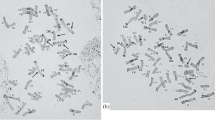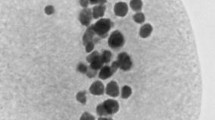Abstract
Results of cytogenetic analysis of microsporogenesis in rye-triticale F1 hybrids (RRABR, 5x = 35) are presented. Meiosis of pentaploids is described as the key stage in the synthesis of secalotriticum, lines with intergenomic substitutions of chromosomes, or alloplasmic rye and wheat lines. Properties of meiotic processes and cytological mechanisms in formation of functional gametes and plants of various genomic and chromosomal composition are discussed.
Similar content being viewed by others
REFERENCES
Darvey, N.L., Creating Genetic Variability in Triticale and Its Potential for Breeding: 2. Quality Traits, 3. International Consortium for Doubled Haploids, Proc. 4th Int. Triticale Symp., Juskiv, P., Ed., Red Deer, 1998, vol. 1, no.1, pp. 13–21.
Gordei, I.A., Bel’ko, N.B., Khokhlova, S.A., et al., Specific Features of the Formation and Reconstruction of Karyotypes in Secalotriticum, Tsitologiya, 2000, vol. 41, no.12, pp. 1059–1060.
Bel’ko, N.B., Gordei, I.A., Khokhlova, S.A., and Lyusikov, O.M., Morphobiological Features of Rye-Triticale F1 Amphyhaploids, Vestsi Nats. Akad. Navuk Belarusi, Ser. Biyal. Navuk, 2000, no. 3, pp. 60–63.
Gordei, G.M., Gordei, I.A., Novikova, L.V., and Klimenko, E.P., USSR Inventor’s Certificate no. 1734602, 1992.
Gordei, I.A., Bel’ko, N.B., Lyusikov, O.M., et al., Specific Features of the Crossability of Di-and Tetraploid Rye with Hexaploid Triticale, Vestsi Nats. Akad. Navuk Belarusi, Ser. Biyal. Navuk, 1999, no. 2, pp. 39–42.
Kleckner, N. and Weiner, B.M., Potential Advantages of Unstable Interactions for Pairing of Chromosomes in Meiotic, Somatic and Premeiotic Cells, Cold Spring Harbor Symp. Quant. Biol., 1993, vol. 58, no.4, pp. 553–565.
Jianhimiak, A., Uklad chromosomow w jadrze interfazowym, Post. Biol. Komorki, 1987, vol. 14, no.3, pp. 137–254.
Leitch, A.R., Schwarzaher, T., Mosgoller, W., et al., Parental Genomes Are Separated Throughout the Cell Cycle in a Plant Hybrid, Chromosoma, 1991, vol. 101, no.2, pp. 206–213.
Schwarzacher, T., Leitch, A.R., Bennett, M.D., and Heslop-Harrison, J.S., In Situ Localization of Parental Genomes in a Wide Hybrid, Ann. Bot., 1989, vol. 64, pp. 315–324.
Mikhailova, E.I., Naranjo, T., Shepherd, K., et al., The Effect of the Wheat Ph1 Locus on Chromatin Organization and Meiotic Chromosome Pairing Analyzed by Genome Painting, Chromosoma, 1998, vol. 107, no.6, pp. 339–350.
Sybenga, J., What Makes Homologous Chromosomes Find Each Other in Meiosis? A Review and an Hypothesis, Chromosoma, 1999, vol. 108, no.4, pp. 209–219.
Sosnikhina, S.P., Kirillova, G.A., Mikhailova, E.I., et al., Genetic Control of Chromosome Synapsis at Meiosis in Rye Secale cereale L.: The sy19 Gene Controlling Heterologous Synapsis, Rus. J. Genet., 2001, vol. 37, no.1, pp. 71–79.
Feldman, M., Cytogenetic Activity and Mode of Action of the Pairing Homoeologous (Ph1) Gene of Wheat, Crop Sci., 1993, vol. 33, pp. 894–897.
Aragon-Alcaide, L., Reader, S., Miller, T., and Moore, G., Centromeric Behavior in Wheat with High and Low Homoeologous Chromosomal Pairing, Chromosoma, 1997, vol. 106, pp. 327–333.
Vega, J.M. and Feldman, M., Effect of the Pairing Gene Ph1 on Centromere Misdivision in Common Wheat, Genetics, 1998, vol. 148, pp. 1285–1294.
Shchapova, A.I., Kravtsova, L.A., Potapova, T.A., and Silkova, O.G., Role of Rye Chromosomes in the Genetic Control of Equational Division of Univalents in Wheat-Rue Di-Monosomics, Rus. J. Genet., 1998, vol. 34, no.8, pp. 983–985.
Silkova, O.G., Shchapova, A.I, Potapova, T.A., and Kravtsova, L.A., The Causes of Different Transmission Rates Via Gametes of Two Different Homoeologous Univalents of the Wheat-Rye Di-Monosomic, Rus. J. Genet., 1999, vol. 35, no.6, pp. 664–669.
Author information
Authors and Affiliations
Additional information
__________
Translated from Genetika, Vol. 41, No. 7, 2005, pp. 902–909.
Original Russian Text Copyright © 2005 by Lyusikov, Bel’ko, Shchet’ko, Gordei.
Rights and permissions
About this article
Cite this article
Lyusikov, O.M., Bel’ko, N.B., Shchet’ko, I.S. et al. Construction of Rye-Wheat Amphidiploids with the Cytoplasm of Rye—Secalotriticum (RRAABB, 2n = 42): Meiosis Characteristics in Rye-Triticale F1 Hybrids (RRABR, 5x = 35). Russ J Genet 41, 735–741 (2005). https://doi.org/10.1007/s11177-005-0153-2
Received:
Accepted:
Issue Date:
DOI: https://doi.org/10.1007/s11177-005-0153-2




